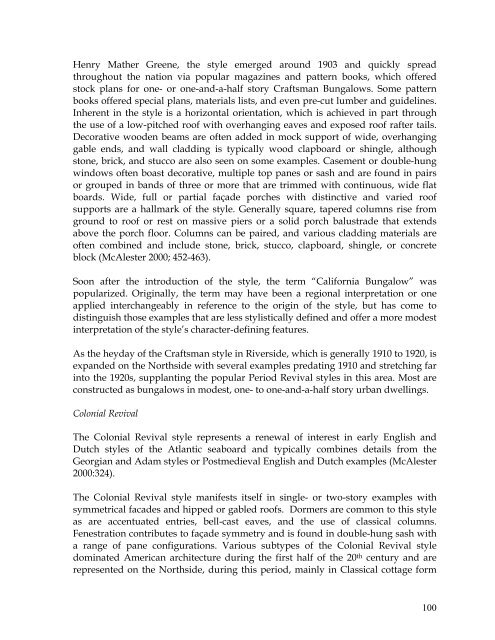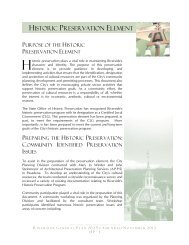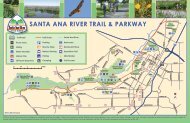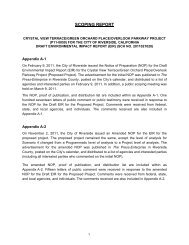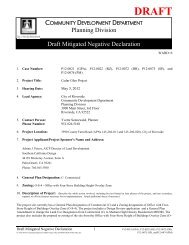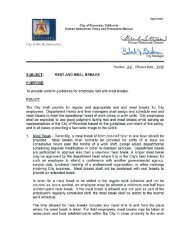Northside - City of Riverside
Northside - City of Riverside
Northside - City of Riverside
You also want an ePaper? Increase the reach of your titles
YUMPU automatically turns print PDFs into web optimized ePapers that Google loves.
Henry Mather Greene, the style emerged around 1903 and quickly spread<br />
throughout the nation via popular magazines and pattern books, which <strong>of</strong>fered<br />
stock plans for one- or one-and-a-half story Craftsman Bungalows. Some pattern<br />
books <strong>of</strong>fered special plans, materials lists, and even pre-cut lumber and guidelines.<br />
Inherent in the style is a horizontal orientation, which is achieved in part through<br />
the use <strong>of</strong> a low-pitched ro<strong>of</strong> with overhanging eaves and exposed ro<strong>of</strong> rafter tails.<br />
Decorative wooden beams are <strong>of</strong>ten added in mock support <strong>of</strong> wide, overhanging<br />
gable ends, and wall cladding is typically wood clapboard or shingle, although<br />
stone, brick, and stucco are also seen on some examples. Casement or double-hung<br />
windows <strong>of</strong>ten boast decorative, multiple top panes or sash and are found in pairs<br />
or grouped in bands <strong>of</strong> three or more that are trimmed with continuous, wide flat<br />
boards. Wide, full or partial façade porches with distinctive and varied ro<strong>of</strong><br />
supports are a hallmark <strong>of</strong> the style. Generally square, tapered columns rise from<br />
ground to ro<strong>of</strong> or rest on massive piers or a solid porch balustrade that extends<br />
above the porch floor. Columns can be paired, and various cladding materials are<br />
<strong>of</strong>ten combined and include stone, brick, stucco, clapboard, shingle, or concrete<br />
block (McAlester 2000; 452-463).<br />
Soon after the introduction <strong>of</strong> the style, the term “California Bungalow” was<br />
popularized. Originally, the term may have been a regional interpretation or one<br />
applied interchangeably in reference to the origin <strong>of</strong> the style, but has come to<br />
distinguish those examples that are less stylistically defined and <strong>of</strong>fer a more modest<br />
interpretation <strong>of</strong> the style’s character-defining features.<br />
As the heyday <strong>of</strong> the Craftsman style in <strong>Riverside</strong>, which is generally 1910 to 1920, is<br />
expanded on the <strong>Northside</strong> with several examples predating 1910 and stretching far<br />
into the 1920s, supplanting the popular Period Revival styles in this area. Most are<br />
constructed as bungalows in modest, one- to one-and-a-half story urban dwellings.<br />
Colonial Revival<br />
The Colonial Revival style represents a renewal <strong>of</strong> interest in early English and<br />
Dutch styles <strong>of</strong> the Atlantic seaboard and typically combines details from the<br />
Georgian and Adam styles or Postmedieval English and Dutch examples (McAlester<br />
2000:324).<br />
The Colonial Revival style manifests itself in single- or two-story examples with<br />
symmetrical facades and hipped or gabled ro<strong>of</strong>s. Dormers are common to this style<br />
as are accentuated entries, bell-cast eaves, and the use <strong>of</strong> classical columns.<br />
Fenestration contributes to façade symmetry and is found in double-hung sash with<br />
a range <strong>of</strong> pane configurations. Various subtypes <strong>of</strong> the Colonial Revival style<br />
dominated American architecture during the first half <strong>of</strong> the 20 th century and are<br />
represented on the <strong>Northside</strong>, during this period, mainly in Classical cottage form<br />
100


